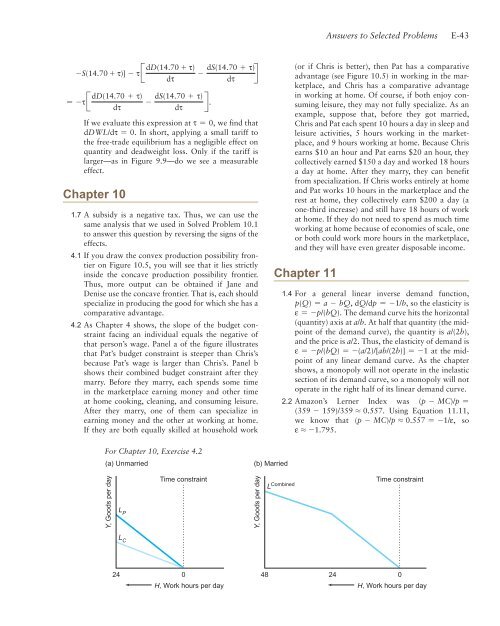Answers to Selected Problems
Answers to Selected Problems
Answers to Selected Problems
You also want an ePaper? Increase the reach of your titles
YUMPU automatically turns print PDFs into web optimized ePapers that Google loves.
dD(14.70 + τ)<br />
-S(14.70 + τ)] - τ J -<br />
dτ<br />
dS(14.70 + τ)<br />
dD(14.70 + τ)<br />
= -τ J<br />
dτ<br />
- dS(14.70 + τ)<br />
R.<br />
dτ<br />
R<br />
dτ<br />
If we evaluate this expression at τ = 0, we find that<br />
dDWL/dτ = 0. In short, applying a small tariff <strong>to</strong><br />
the free-trade equilibrium has a negligible effect on<br />
quantity and deadweight loss. Only if the tariff is<br />
larger—as in Figure 9.9—do we see a measurable<br />
effect.<br />
Chapter 10<br />
1.7 A subsidy is a negative tax. Thus, we can use the<br />
same analysis that we used in Solved Problem 10.1<br />
<strong>to</strong> answer this question by reversing the signs of the<br />
effects.<br />
4.1 If you draw the convex production possibility frontier<br />
on Figure 10.5, you will see that it lies strictly<br />
inside the concave production possibility frontier.<br />
Thus, more output can be obtained if Jane and<br />
Denise use the concave frontier. That is, each should<br />
specialize in producing the good for which she has a<br />
comparative advantage.<br />
4.2 As Chapter 4 shows, the slope of the budget constraint<br />
facing an individual equals the negative of<br />
that person’s wage. Panel a of the figure illustrates<br />
that Pat’s budget constraint is steeper than Chris’s<br />
because Pat’s wage is larger than Chris’s. Panel b<br />
shows their combined budget constraint after they<br />
marry. Before they marry, each spends some time<br />
in the marketplace earning money and other time<br />
at home cooking, cleaning, and consuming leisure.<br />
After they marry, one of them can specialize in<br />
earning money and the other at working at home.<br />
If they are both equally skilled at household work<br />
For Chapter 10, Exercise 4.2<br />
(a) Unmarried<br />
Y, Goods per day<br />
L P<br />
L C<br />
Time constraint<br />
24 0<br />
H, Work hours per day<br />
(b) Married<br />
Y, Goods per day<br />
<strong>Answers</strong> <strong>to</strong> <strong>Selected</strong> <strong>Problems</strong><br />
E-43<br />
(or if Chris is better), then Pat has a comparative<br />
advantage (see Figure 10.5) in working in the marketplace,<br />
and Chris has a comparative advantage<br />
in working at home. Of course, if both enjoy consuming<br />
leisure, they may not fully specialize. As an<br />
example, suppose that, before they got married,<br />
Chris and Pat each spent 10 hours a day in sleep and<br />
leisure activities, 5 hours working in the marketplace,<br />
and 9 hours working at home. Because Chris<br />
earns $10 an hour and Pat earns $20 an hour, they<br />
collectively earned $150 a day and worked 18 hours<br />
a day at home. After they marry, they can benefit<br />
from specialization. If Chris works entirely at home<br />
and Pat works 10 hours in the marketplace and the<br />
rest at home, they collectively earn $200 a day (a<br />
one-third increase) and still have 18 hours of work<br />
at home. If they do not need <strong>to</strong> spend as much time<br />
working at home because of economies of scale, one<br />
or both could work more hours in the marketplace,<br />
and they will have even greater disposable income.<br />
Chapter 11<br />
1.4 For a general linear inverse demand function,<br />
p(Q) = a - bQ, dQ/dp = -1/b, so the elasticity is<br />
ε = -p/(bQ). The demand curve hits the horizontal<br />
(quantity) axis at a/b. At half that quantity (the midpoint<br />
of the demand curve), the quantity is a/(2b),<br />
and the price is a/2. Thus, the elasticity of demand is<br />
ε = -p/(bQ) = -(a/2)/[ab/(2b)] = -1 at the midpoint<br />
of any linear demand curve. As the chapter<br />
shows, a monopoly will not operate in the inelastic<br />
section of its demand curve, so a monopoly will not<br />
operate in the right half of its linear demand curve.<br />
2.2 Amazon’s Lerner Index was (p - MC)/p =<br />
(359 - 159)/359 L 0.557. Using Equation 11.11,<br />
we know that (p - MC)/p L 0.557 = -1/ε, so<br />
ε L -1.795.<br />
L Combined<br />
Time constraint<br />
48 24<br />
0<br />
H, Work hours per day
















